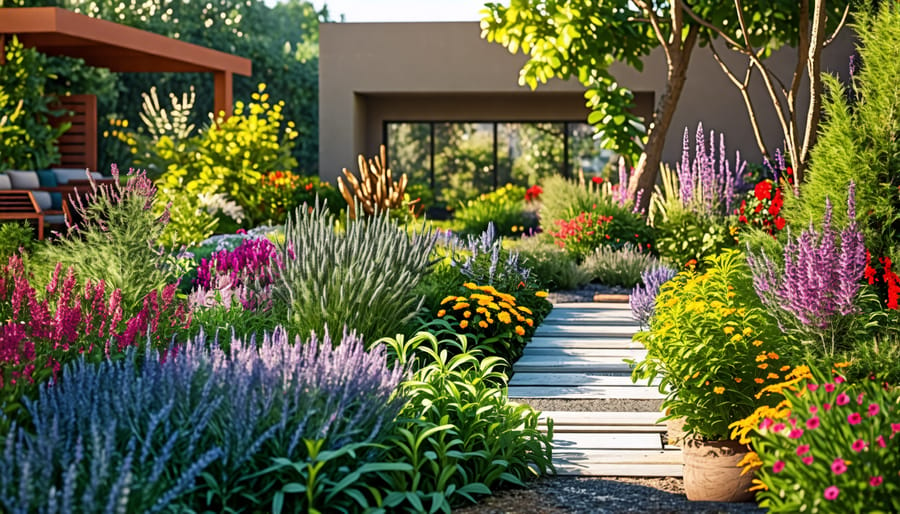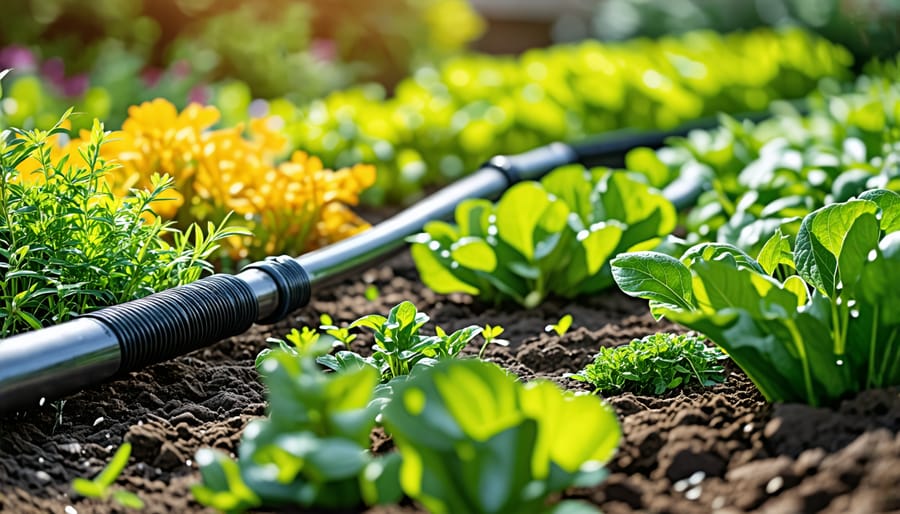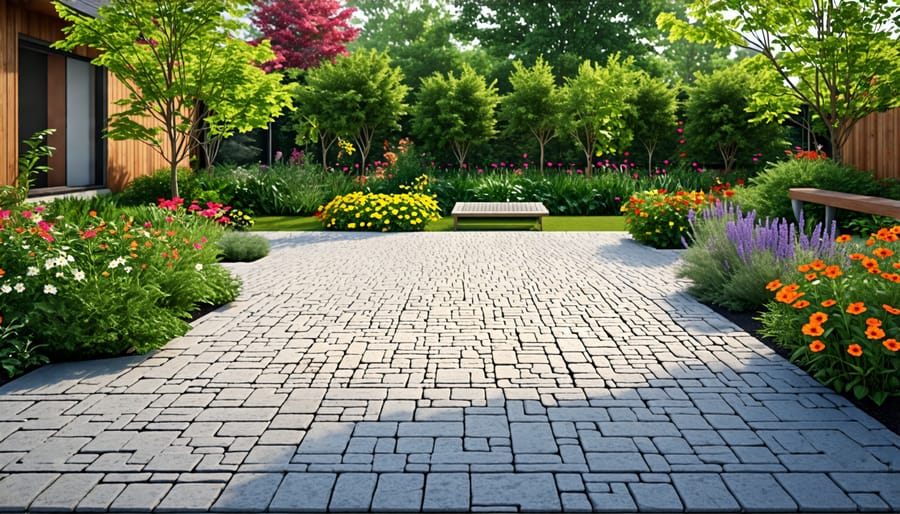Plant native species that thrive in your local climate to reduce the need for excessive watering and chemical inputs. Utilize drip irrigation systems, which deliver water directly to the roots, minimizing waste and promoting healthier plants. Create a rain garden by channeling roof and driveway runoff into a landscaped area filled with water-tolerant plants to enhance aesthetic appeal while managing stormwater naturally. Incorporate compost and organic mulch to improve soil health, retain moisture, and suppress weeds without harsh chemicals. For more ideas on sustainable practices, explore eco-friendly living strategies that complement your landscaping efforts.
Sustainable Plant Choices

Native Plant Selections
Embracing native plants in your eco-friendly landscaping is not only a sustainable choice but also a smart one for creating a low-maintenance garden. Native plants are intrinsically adapted to your local climate and soil conditions, meaning they require less water, fewer fertilizers, and minimal pest control. This resilience translates to savings on resources and time, allowing you to enjoy a beautiful and thriving garden with less effort. Beyond practicality, native plants promote local biodiversity by providing essential habitats for pollinators like bees and butterflies. Imagine your garden buzzing with life, a testament to your eco-conscious choices. Investing in native varieties also helps reduce the competition from aggressive, non-native species, preserving the natural balance in your area. Explore a variety of textures, colors, and forms that native plants offer to craft an inviting outdoor space where nature meets nurture seamlessly. Dive into the vibrant world of native landscaping and watch your yard flourish sustainably.
Drought-Tolerant Beauties
When it comes to creating a beautiful garden that also respects the environment, choosing drought-tolerant plants is a key strategy. These hardy beauties not only help conserve water but also require less maintenance, making them ideal for busy homeowners and renters. Imagine a garden filled with the vibrant hues of lavender, the bold textures of succulents, and the delicate grace of yarrow, all thriving with minimal watering. By selecting plants like these, you’re not just beautifying your space but also doing your part to reduce water waste.
Lavender is a fantastic choice, offering both fragrance and a splash of color. Its deep roots seek out moisture from the soil, allowing it to flourish even in dry conditions. Similarly, succulents like agave and sedum are champions of dry climates, storing water in their fleshy leaves and transforming any garden with their unique shapes and shades. Yarrow, with its feathery foliage and clusters of yellow, white, or pink flowers, is another excellent selection, known for its ability to flourish in hot, sunny spots with little care.
If you’re looking to spice up your garden with ornamental grasses, blue fescue and fountain grass are great options. They’re low-maintenance and add a dynamic movement to your outdoor area. By integrating these water-wise plants, your garden not only becomes a low-maintenance sanctuary but also a testament to sustainable living.
Water Conservation Techniques
Efficient Irrigation Systems
Imagine transforming your garden into a lush paradise while conserving water—drip irrigation and smart watering systems make it possible. Drip irrigation gently delivers water directly to plant roots, minimizing evaporation and runoff. It’s a simple yet effective system to set up in your garden beds, using hoses with tiny perforations laid along the soil. Perfect for DIY enthusiasts, drip irrigation is not only efficient but adaptable to various plant types and landscapes.
Smart watering systems, on the other hand, take water conservation a step further by using weather data and soil moisture sensors. These intelligent systems adjust watering schedules based on real-time conditions, ensuring your plants get exactly what they need, when they need it. This thoughtful technology can be controlled right from your smartphone, offering an effortless way to save water and lush up your landscape.
By opting for these modern solutions, you’re not just saving water; you’re making a long-lasting, eco-friendly choice for your garden.

Rainwater Harvesting
Collecting and utilizing rainwater for your landscape is a simple and sustainable way to conserve water and nurture your garden. First, install a rain barrel beneath your downspout to capture runoff from your roof. These barrels often come with spigots, making it easy to fill up a watering can or attach a hose for garden use. You can also create your own DIY rainwater collection system with minimal materials and effort.
Once you’ve gathered the rainwater, focus its usage on thirsty plants like vegetables, flowers, and shrubs. Mulching around these plants will not only keep the soil moist but also make your rainwater efforts more effective. It’s also important to use rainwater sooner rather than storing it for long periods to prevent stagnation and algae growth.
With these simple steps, you’ll effectively support your landscape while making a positive impact on the environment, turning each rainfall into a resourceful gardening opportunity.
Chemical-Free Lawn Care
Organic Fertilizers
Looking to nourish your lawn in an eco-friendly way? Consider switching to organic fertilizers, which provide essential nutrients without the synthetic chemicals found in conventional products. Made from natural materials like compost, manure, and bone meal, these fertilizers work with the soil’s ecosystem to promote healthy grass and plant growth. Not only do they enrich your lawn, but they also foster a thriving habitat for beneficial microorganisms that enhance soil fertility. Plus, using organic fertilizers helps reduce pollution from chemical runoff, making them a safe choice for families and pets. You can even make your own compost at home—an easy, sustainable DIY project that transforms kitchen scraps into nutrient-rich fertilizer. Embrace organic options for a greener, more sustainable yard.
Natural Pest Control
Keeping your garden healthy and thriving naturally means getting creative with how you handle those pesky invaders. Why not start by inviting beneficial insects like ladybugs or lacewings into your space; they love munching on aphids and other pests. Another friendly option is using homemade sprays, like a simple mixture of water, dish soap, and a few drops of neem oil, to tackle unwanted bugs. Companion planting is another effective strategy; planting herbs like basil, mint, or marigold can naturally deter pests due to their strong scents. And while you’re considering natural approaches, remember that eco-friendly cleaning tips can extend beyond your garden to refresh your home. With these strategies, you’ll maintain a thriving ecosystem without resorting to harmful chemicals.
Waste Minimization and Composting
Starting a Compost Heap
Starting a compost heap is a rewarding way to enrich your garden soil and reduce waste—perfect for eco-friendly landscaping. Begin by choosing a shaded spot in your yard that’s accessible yet away from direct view. Assemble a simple bin or a pile using organic materials like fruit scraps, vegetable peels, and garden clippings. Avoid adding meat, dairy, or diseased plants. Layer these materials with dry leaves or shredded paper to promote aeration. Turn your compost weekly with a pitchfork to speed up decomposition and keep it moist, not soggy. In a few months, you’ll have nutrient-rich compost to boost your garden’s vitality.
Reusing Garden Waste
Reusing garden waste is a fantastic way to enrich your garden while minimizing waste. Start by creating a simple compost pile with kitchen scraps and yard clippings to improve soil quality. Got fallen leaves? Turn them into mulch to protect plants and retain moisture. Even old branches can have a second life; use them to outline garden paths or create rustic trellises for climbing plants. For a creative spin, try crafting unique DIY garden decorations, such as planters from broken pots or bird feeders from pine cones. Embracing these practices not only helps the environment but also makes it easy to create a cozy home outdoors.
Hardscaping with Eco-Friendly Materials

Recycled Material Options
Using recycled materials in landscaping not only benefits the environment but also adds unique charm to your outdoor space. By choosing recycled options for patios, walkways, and other structural elements, you’re helping reduce waste and promoting sustainable practices. Materials like reclaimed wood, recycled bricks, and repurposed concrete offer durable and weather-resistant options that are often more affordable than newly manufactured products. These recycled materials come with their own stories and character, adding an authentic touch to your design. Transform old pallets into garden furniture or use recovered stones for a rustic pathway. This way, you not only enhance your garden’s beauty but also showcase your commitment to sustainability. By embracing these eco-friendly choices, you contribute to conserving natural resources while enjoying a stylish and environmentally conscious landscape.
Permeable Paver Solutions
Permeable pavers are a fantastic addition to any eco-friendly landscape. They allow water to naturally seep into the ground, significantly improving water absorption and reducing troublesome runoff. By mimicking the natural process of water filtering through soil, they help replenish groundwater and minimize erosion. These pavers are ideal for driveways, walkways, or patios, blending functionality with aesthetics. Made from materials like concrete, brick, or stone, they are designed with gaps or a porous structure to let water flow through. Installing permeable pavers is a doable DIY project or can be handled by professionals for larger areas. Besides being eco-friendly, they offer the added benefit of being visually appealing, enhancing property value while contributing to a sustainable environment.
Conclusion
In embracing eco-friendly landscaping, we’ve explored a range of sustainable practices that not only enhance the beauty of your outdoor space but also contribute positively to the environment. By selecting native plants, conserving water through efficient irrigation systems, and implementing soil health strategies, homeowners and DIY enthusiasts can create vibrant landscapes that support biodiversity and reduce their carbon footprint. These efforts go beyond aesthetics, offering long-term financial savings and reduced maintenance. As you pursue these green practices, know that each step adds value, creating harmonious spaces that benefit not just you and your family, but the planet as a whole.
